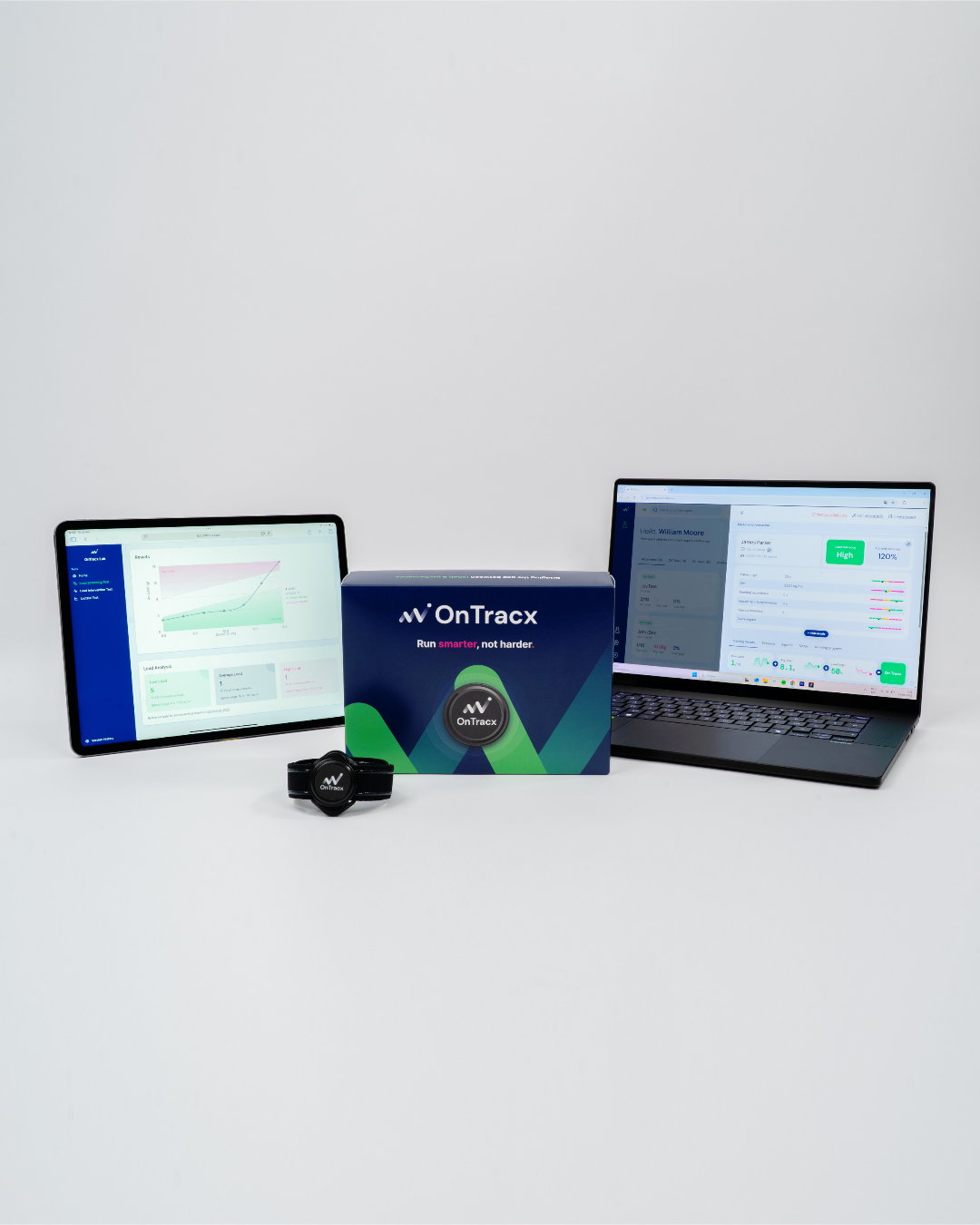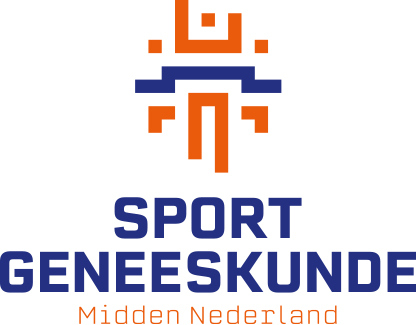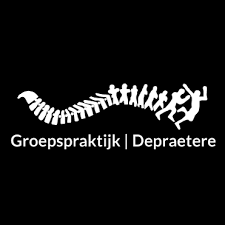Stay tuned,
to stay OnTracx
Receive the latest updates and tips & tricks
Monitor biomechanical load and optimize return-to-run
The world’s first load-based return-to-run programs that match biomechanical load to each patient’s load tolerance.
50%
The chance that runners will relapse within a year after rehab.
>70%
The share of all injuries caused by too much load on the body.
62%
Less injury risk if you manage load properly.
As if every run were on force plates, it delivers smarter load management for experts who specialize in

Rehab of overuse injuries:
Develop fully personalized return-to-run programs and optimize every phase of recovery.

Running biomechanics & screening
Assess, analyze and benchmark biomechanical load within minutes for data-driven insights.

Exercise & lactate testing
Combine physiological and biomechanical data to design smarter training plans to maximize results while minimizing injury risk.
The complete load management solution for professionals
Strap up the OnTracx sensor to the athlete and begin collecting validated load data during training.
After each session, data is uploaded to your OnTracx Pro environment for analysis and safe load progression monitoring.
Use the OnTracx Lab module to investigate the effects of interventions & better understand each athlete’s unique biomechanics.
How OnTracx helps you stay in control, save time, and reduce injury risk with personalized care
Stay informed about early warning signs and athlete adherence to guidelines, with the ability to review detailed data from each session
Measure & monitor what truly matters
Science dictates that most overuse injuries are caused by an excessive amount of load on the muscles and bones of athletes. OnTracx allows you to track that load, for every step an athlete takes and provides clear direction for safe progression.
Find the intervention that really reduces injury risk
The effect of an intervention (changing speed, cadence, footwear) on load is very individual. OnTracx gives you the tools to find the intervention that effectively reduces load for each athlete.
Follow-up in & outside your practice
Never lose sight of your athletes, even when they are training at home. Educate runners about load management & their training errors to avoid future injuries.
See which athletes need your attention
Too many athletes, not enough time? We flag those at risk who need your attention, so you can prioritize the right athletes, act fast, and focus on what matters most.
Let's fix this together
Use OnTracx Pro &
lead with precision
The load management software for healthcare professionals and coaches that helps you prevent overload injuries and bridge the gap between rehab, return to run & consistent training.
Give athletes a clear reason why
Show patients tangible load patterns and explain the why behind every training and intervention decision using objective data. This helps athletes understand the process, and empower them to take an active role in progressing safely and effectively.
First to track cumulative load
Volume based load management, like increasing running distance by 10% each week, have proven to be ineffective in preventing overuse injuries because it overlooks individual differences and true cumulative load, both crucial for safe return-to-run and smarter injury prevention.
Clear reports, ready to share
Our Lab module delivers personalized reports showing which interventions have the greatest impact. You can easily share the PDF report or export the raw data if needed.
A license that pays off
Unlike many other tools, OnTracx Pro creates new income opportunities through more complete injury prevention screenings, targeted coaching for high-risk athletes, and ongoing remote monitoring.

Essential tools for effective rehab & injury prevention
Tolerance profile
Customize load progression based on individual risk factors for a safer and more personalized training approach.

Load progression
Keep track of weekly training load, including adaptive load progression recommendations that adjust based on recent training load to ensure athletes stay within safe progression limits.

Weekly load target
A weekly load target is automatically set in your athlete's app, making it easy to plan and compare this week's accumulated training load with past weeks.

On-Off Tracx classification
Easily identify and filter athletes at risk of injury & intervene with the right intervention when necessary.

Pain & comfort
Track pain over time to gain valuable insights. Leverage this data to adjust training loads effectively and intervene when necessary.

Running session statistics
Break down individual post-run data for optimal training adjustments and pattern recognition.

Injury history
Log past injuries to gain valuable insights into recovery patterns and training adjustments.

Load intervention screening
Test and analyze different interventions to reduce running load, including cadence changes, surface types, footwear, and more.
Load screening test
Compare running load to scientifically validated benchmarks and adjust training progression based on the athlete's unique load profile.
Load speed profiling
Analyze how speed impacts running load, and determine individual physical and mechanical training zones to guide safer training plans, minimize injury risk, and ensure training consistency.
Want to help shape what’s next?
We co-create to ensure every solution is user-friendly and valuable to you. Share your ideas or suggest improvements to help build the future of injury-free running.
Two plans. One platform. Your choice.
Pro pack
Sensors + 12-month full access OnTracx Pro software
amount of sensors in the pack
€ 592.00
excl. VAT (includes discount on sensors)
+ €800/year excl. VAT for OnTracx Pro license
Ideal for remote athlete monitoring & screening
Never lose sight of your athletes, even when they train at home. Stay informed via the OnTracx Pro platform, master individual training progression, & conduct screenings using the OnTracx Lab.
Everything in Essential pack, plus
- 10% discount on sensors when you buy 4 to 7 sensors, and 20% off when you buy 8 or more.
- 12-month full access to OnTracx Pro and add unlimited users & athletes.
- Early access to OnTacx Lab module for free.
- Includes in-person support to get you started.
Essential pack
Sensors only - Inlcudes 4 sensors
(does not include OnTracx Pro license)
€ 659.00
excl. VAT
Ideal for in-practice use
Ideal for in-practice use & professionals sharing sensors with athletes starting or increasing running or impact load, enabling athletes to track load progression independently in their OnTracx app and stay within safe limits.
The Essential pack does not include the connection to the OnTracx Pro platform for efficiently monitoring athletes remotely.
For professionals looking to monitor multiple athletes outside the clinic, we recommend the OnTracx Pro pack for efficient multi-athlete management.
- The sensors seamlessly connect with a tablet or smartphone - see compatible devices.
- 2 years of guarantee on OnTracx sensors included.
- Includes a step-by-step manual so you can immediately elevate rehabilitation and injury prevention from day one.
Testing OnTracx for personal use outside the practice?
Experts who use OnTracx don't rely on guesswork. They measure, monitor, and progress with direction.
Backed-up by science
Did you know our sensor technology is the first validated, award-winning solution for measuring and monitoring mechanical load in the field?

International awards
Most innovative piece of running technology (FBS award)
Research awards
Reliable method to track load during running outside lab-settings (BJSM award)
Industry awards
High societal relevance & scientific expertise (BiR&D award)

Still have questions? We tried to answer the most important ones by topic.
Can’t find yours? Email us at info@ontracx.com
Why is volume based load management not effective in preventing overuse injuries?
Because running distance & duration does not equal to actual mechanical load on the body.
It's not just about how far you ran, it's about the actual load your body experienced.
Recent scientific evidence shows that more than 70% of all running injuries occur when mechanical load exceeds what the body can handle. This load is influenced by multiple factors including running speed, running style, terrain elevation, surface type, and footwear selection. Studies demonstrate that experienced load varies significantly between runners even at identical paces.
Volume-based load management, like increasing running distance by not more than 10% each week, fails to account for actual mechanical load & individual differences and is proven to be ineffective to prevent running injuries.
Previously, mechanical load could only be measured on treadmills in specialized, expensive lab settings for brief periods. This made analysis costly, difficult to apply in real-world conditions, and impossible for long-term load monitoring.
With the introduction of the OnTracx sensor and related algorithms we enable accurate load measurement and management during every run, with the ultimate goal of preventing running related overuse injuries.
What does the OnTracx sensor actually measure?
The OnTracx sensor measures the acceleration of the tibia during running.
Scientific research showed that the peak of this tibial acceleration (PTA; this is when the foot hits the ground) is strongly related to the shock or impact measured in the lab. As such, OnTracx allows measuring the impact or shock for every step, in an outdoor setting (where and when it really matters). This allows runners to work on injury prevention based on two validated load metrics:
- Impact (in G-forces): the force at footstrike, primarily related to stress fractures and plantar fasciitis
- Maximal load (in body weight equivalents): the peak force during stance phase, associated with injuries like Achilles tendinopathy and patellofemoral pain
More information available in this article.
How accurate is the measurement of the sensor?
Here it gets a bit scientific, but the correlation between the signal from the sensor and the laboratory measure shows a very strong correlation of r = 0.91.
This means that our sensor-based measure is almost the same as the load parameter calculated in lab-settings. As a spin-off from Ghent University and its Sport Science Laboratory - Jacques Rogge, we care about the accuracy and validity of our product, and do not aim to create something that looks good but doesn't really do the job.
Our measurements have been validated with the so-called ‘golden standard methods’. This means that we checked - and verified - that the load measured by Ontracx is similar to the one measured in specialized laboratory settings. This however doesn’t mean that our product is perfect. It just means we’re confident that what we’re measuring is correct enough to be used in real-world settings.
Will athletes never get injured again by using OnTracx?
Unfortunately, that’s still possible.
Although most running injuries are caused by an excessive amount of mechanical load, they also depend on a variety of other parameters. This makes it very hard to estimate whether someone will get injured or not, as it is not straightforward to quantify and interpret each of the parameters and their mutual relationships.
However, knowing the individual load profile of patients can provide valuable information to prevent (re-)injury and to optimize the rehabilitation process. This is because mechanical load is considered the most important risk factor for overuse injuries in running, and should be increased gradually (based on objective data) in a return-to-run context.
Why is the sensor placed around the lower leg?
We strategically placed the sensor on the lower leg because, during extensive testing, it proved to be the most reliable location to measure mechanical load during running. Here's why:
Specificity: The lower leg experiences the first rapid deceleration as your foot strikes the ground. Which only can be captured by measuring at that specific location.
Consistency: Unlike other locations, such as in the shoe, on the laces, or on the lower back, attaching the sensor around the lower leg minimizes interference from external factors and ensures your data reflects actual running load.
Validation: Through rigorous lab testing, we found that the lower leg provided the most accurate and reliable data.
How should you attach the sensor around your leg?
It’s important to place the sensor the same way every time you go for a run. Here are some guidelines for proper sensor attachment:
Place the sensor about 10cm above your inner ankle, on the flat part of your shin bone. Always attach the strap firmly, in a similar way, and on the same leg (we advise to put it on the leg that suffers (most) from running injuries).
To make this more clear, we made a video that shows you how to attach it exactly!
More info available in this article.
Why is the sensor placed around only one leg?
Currently this is for practical reasons.
Bilateral load quantification can offer valuable information in the return-to-run process. However, mechanical load can currently only be measured based on one leg (but we’re working on it). We advise you to attach the sensor, during rehabilitation, at the injured leg.
What is advised load progression, and why is it important in injury prevention?
Advised load progression refers to the recommended weekly increase in mechanical load in percentage.
It is calculated automatically for each athlete in the Tracx Pro platform based on the athlete’s tolerance profile. This progression rate, typically guides clinicians in planning individualized training or return-to-run programs. By controlling the rate at which load increases, OnTracx helps minimize the risk of overload and reduces the likelihood of (re)injury.
What is a load tolerance profile and how is it calculated?
The tolerance profile reflects how well an athlete’s body can cope with mechanical load.
This feature is available exclusively within the OnTracx Pro platform and is calculated during the intake phase when registering a new athlete.
Using validated parameters, the platform generates a personalized tolerance profile. Based on this profile, OnTracx assigns an advised load progression: a weekly percentage increase in mechanical training load tailored to the athlete’s capacity.
Athletes with a low tolerance profile receive a more conservative progression rate, while those with a high tolerance profile are assigned a more progressive rate. This ensures that training and rehabilitation are matched to the individual’s readiness, supporting safer and more effective training & return-to-run plans.
Which professionals benefit most from using OnTracx?
OnTracx is designed for professionals who manage training load, injury risk, and return-to-sport decisions.
It is particularly valuable for those involved in:
- Rehabilitation & performance coaching: The OnTracx Pro platform supports individualized load progression and long-term remote monitoring, making it ideal for professionals offering return-to-run programs, post-rehabilitation guidance, or athlete coaching for injury prone-athletes.
- Injury prevention & intervention screening: The OnTracx Lab module is particularly useful for those conducting biomechanical assessments and exploring intervention strategies, such as adjusting cadence, footwear, or running surface to reduce load for each step and prevent overuse injuries.
- Performance and fitness testing: The OnTracx Lab module helps identify optimal training zones combining physical and mechanical training load to guide safer, more efficient programs.
As such, OnTracx is well suited for physiotherapists, running coaches, medical doctors, podiatrists, and other professionals focused on keeping runners injury-free, progressing safely, and returning to sport with confidence.
Are OnTracx sensors required to use OnTracx Pro and Lab?
Yes, an OnTracx sensor is required to use both the OnTracx Pro platform and OnTracx Lab.
The platforms rely on objective and individual biomechanical load data captured by the OnTracx sensor to monitor load progression trends, perform load screenings and load intervention tests. Without a sensor, no load data can be recorded or analyzed.
Is OnTracx a medical device?
No, OnTracx is not a medical device.
However, our innovative technology is designed to effectively manage mechanical load on the lower legs during running. Although not a medical device, our solution can be very relevant for injury prevention or rehabilitation purposes. Always consult a healthcare professional for personalized medical advice. Please take a look at our terms of use for further details.
Can athletes buy a sensor themselves?
Yes, athletes can order an sensor via our website using the unique discount code linked to your practice, giving them 10% off.
Each purchase through your code also contributes to a discount on your OnTracx Pro license — ranging from 10% to 100%, based on the number of sensors sold over a 12-month period. This supports patient engagement while allowing you to maintain seamless (remote) follow-up without added effort.
Need your unique discount code or more info about our partnership program? Contact us at info@ontracx.com
For which type of injuries is OnTracx (most) relevant?
Especially tibial stress fractures, plantar fasciitis, achilles tendinopathy and patellofemoral pain have been shown to be related to a very high variety of parameters of which an excessive amount of load is considered the most crucial one - by far! Based on the available literature, managing load has already been shown to be one of the most effective ways to successfully reduce the number of running injuries.
How can you implement OnTracx into your daily practice?
OnTracx gives you the possibility to measure mechanical load in an objective manner, both in the clinic and outside of the clinic.
This means that OnTracx offers a huge advantage on several fronts during and post rehabilitation:
- When a patient is ready to start running again, the mechanical load can be objectively mapped from step one. This allows healthcare professionals to gradually increase the mechanical load, and as such not ‘overload’ the athlete from the beginning. Additionally, OnTracx allows to explain the importance of mechanical load to athletes (i.e. as an educational tool), for whom the concept ‘load’ is often difficult to understand.
- When running on a treadmill in a clinical practice, the mechanical load can be completely different than when an athlete runs outside the clinical setting (just think of the cushioning effect of a treadmill, and the stiff surface of concrete). With OnTracx, the mechanical load during running can also be mapped outside the clinical context (i.e. remote monitoring), in order to provide the athlete with even better care, and a better follow-up.
Why focus on load management during the return-to-run process?
In the return-to-run phase it is crucial that the perceived load on the body is built up gradually and in an objective manner. And this for several reasons:
- Since the athlete had an overuse injury, this means that the body was loaded too much in the past. As such, the athlete cannot simply 'return' to his or her initial state of training.
- Exercise therapy has been shown to be effective in avoiding overuse injuries, and is therefore crucial in a rehabilitation context. However, exercise therapy takes quite some time before it becomes effective (up to months). It is therefore imperative to focus on strengthening the body during rehabilitation, as well as identifying and gradually increasing the mechanical load on patients.
The latter is called 'proper load management', and is exactly what OnTracx offers.
Is there an ‘optimal’ running style to avoid running injuries?
Simply put: no, there isn’t.
Current scientific evidence shows that there’s no such thing as a ‘perfect’ running style that every runner should adopt, when it comes down to injury prevention or rehabilitation of overuse injuries. There are two important aspects here to take into account:
- The running style of a patient (also called ‘kinematics’) can influence the way his or her body is loaded, BUT…
- … a certain change in running style (for example increasing cadence or step frequency) can lead to a reduction in the experienced mechanical load for some runners, but to an increase for others.
Changes in running technique can thus be effective in reducing mechanical load, but it needs to be measured (on an individual level) to know this. Here, OnTracx can help in supporting the right intervention.
However, it is insufficient to only focus on running technique when working on injury prevention, or when trying to rehabilitate from injury. That’s why OnTracx measures the experienced mechanical load on the level of the (individual) runner.
Learn more about how OnTracx helps you prevent overuse injuries in this article.
Should every athlete aim to reduce load on their body during running?
Absolutely not.
One of the most important pieces of advice for any athlete is this: if they don’t often suffer from injuries, they should continue running as they are. Altering running style and/or training regime can also have a reverse effect, especially when drastically making changes in a short period of time (which we advise not to do).
Consequently, our product is not doing any magic, nor is it a quick fix for all running-related injuries. Instead, with OnTracx we aim to add relevant information that will help profesionals make personalized decisions.
Can OnTracx also be used to measure mechanical load during other activities than running?
Yes that’s possible, but only unidirectional and dynamic movements.
OnTracx allows you to discover, both as a patient and a healthcare professional, how much mechanical load the muscles and bones of your lower legs endure while performing other (dynamic and unidirectional) movements such as a drop jump, forward jumps, single leg hops, and so on. As a result, OnTracx can be used as an ‘educational tool’ to teach patients what mechanical load is, and to demonstrate how much load a runner/patient endures during running, step by step.
Did you know that the mechanical load of a single step during a running activity is higher compared to most training drills used in a rehabilitation context?
How can I test the effect of cadence or speed on load?
With the intervention screening feature in OnTracx Lab, you can assess how changes in cadence or speed affect an athlete’s experienced load.
The OnTracx sensor measures both load and cadence in real time. Simply record a baseline, apply a change (e.g. higher cadence or varied speed), and compare the results. Each condition should be sustained for at least 60 seconds for reliable data.
This helps identify effective, athlete-specific load management strategies.
Can I add additional athletes to my practice in OnTracx Pro?
Yes, you can add new athletes yourself for free to your OnTracx Pro environment at any time. There is no limit to the number of athletes that can be linked to your practice.
You can simply add an athlete directly via the platform by sending them an invitation to their email address. Once they accept, you can label them as ‘in rehab’ or ‘out of rehab’, and complete their load tolerance profile. This process allows you to personalize their advised load progression and begin monitoring load data immediately from their first session with the OnTracx sensor.
Can I add additional users to my practice in OnTracx Pro?
Yes, you can add new users for free to your OnTracx Pro environment at any time. There is no limit to the number of users that can be linked to your practice.
To add a new team member simply email us at onboarding@ontracx.com with their details. We'll take care of the rest and ensure they’re granted access to your shared environment.
With which devices can I use OnTracx?
OnTracx is designed to be flexible and accessible across multiple devices to support both in-practice and field-based use.
See list of compatible mobile devices.
Is OnTracx compatible with sportwatches?
While OnTracx is not yet fully integrated with all sportwatches, this functionality is actively in development. Currently, OnTracx is compatible with Garmin! You can view your load in real-time directly on your Garmin watch while running—completely phone-free. Read here how to add the OnTracx load field to your Garmin and start tracking immediately. Compatibility with other major brands will follow.
In the meantime, we are also working on a Strava integration, which will allow us to combine OnTracx load data with additional metrics from a wide range of sportwatches when running sessions are uploaded to Strava.
Is OnTracx compatible with other screening or testing software?
While OnTracx does not directly integrate with external screening or testing platforms, the OnTracx Lab module offers easy export options to complement your existing workflow.
You can easily export raw data in CSV format for further analysis, or generate a professionally ready to use PDF report to share with your athletes or integrate into your documentation process.
This flexibility allows you to seamlessly incorporate OnTracx load data into established screening protocols, or to start from scratch with a strong foundation - using a complete assessment and reporting approach.



.png)












































